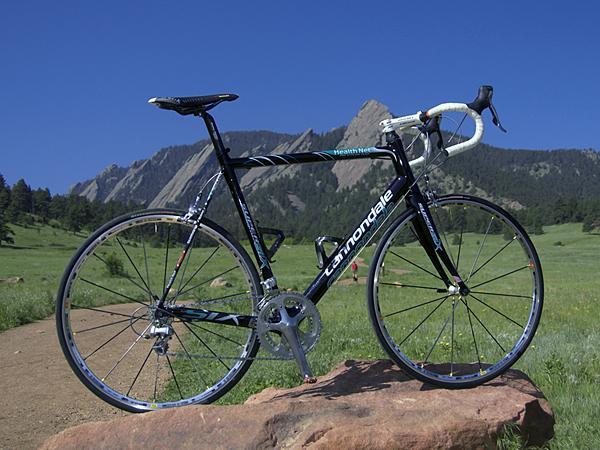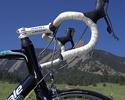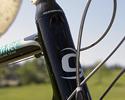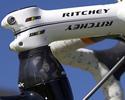
Recently on Cyclingnews.com |
Pro bike, June 6, 2008
Rory Sutherland's Health Net presented by Maxxis Cannondale SuperSix
Storming the US circuit on Cannondale's carbon flyerBy James Huang Aussie native (and Cyclingnews diarist) Rory Sutherland raged through his first year competing on US soil last year with stage wins at the Redlands Classic and Nature Valley Grand Prix, a stage win and the overall at the Joe Martin Stage Race, and even the NRC points title as a result of his consistently high finishes throughout the season. Proving that last year was no fluke, this year is starting out with a similar bang: the 2004 U23 Australian road champion successfully defended his Joe Martin title and then took the overall win at the Mount Hood Classic one week later, winning time trial stages in both events. Needless to say, Sutherland is on a roll: "My season’s been awesome so far in a lot of different ways. I’m really happy!" Cannondale remains the Health Net bike sponsor for 2008 but Sutherland and his team-mates have now swapped to the all-carbon SuperSix model from last year’s aluminum-and-carbon SystemSix. The SuperSix manages to shave some weight from its predecessor but Cannondale engineers have apparently put in a lot of effort to ensure that it’s still stiff enough for its top pro riders. As with the SystemSix, the SuperSix’s front end features a massively-proportioned tapered and oversized 1 1/8"-to-1 1/2" steerer tube matched to a similarly enormous head tube, down tube and top tube. However, this time around the rest of the frame is carbon, too. The bottom bracket area is well reinforced as usual but now it’s molded in one piece with tall carbon chain stays. The small-diameter seat stays are positively anemic-looking in comparison but contribute greatly to the frame’s comfortable ride quality. Sutherland is happy about his new bike’s light weight but admits that shedding grams is far from his highest priority. "I’m not a big light freak," he said. "I’d rather have something that’s super strong but this one is light and strong at the same time. You can sprint on it, you can do everything. One thing that I really like about the bike is that the bottom bracket goes into the stays in one piece and that just creates so much more rigidity in the back of the bike. Cornering on these things is unreal." One new convenience for the team this year is that each rider has been equipped with a home bike that is supposedly 100 percent identical to his race bike. According to Sutherland, Cannondale, Shimano and other team sponsors "really stepped up" this year with their support and the result has been absolutely positive. Riders no longer have to worry about shuttling their primary racing rig back and forth or competing on a bike with which they might not be completely familiar. "What you race on is exactly what you’ve got at home which is fantastic," he said. Sutherland’s training bike was fitted with Mavic R-SYS wheels and Maxxis clincher tires when we caught up with him during a rare stint at his US base in Boulder, Colorado. The team will occasionally swap to Mavic’s more aerodynamic Cosmic Carbone model on race day depending on the conditions but true to his word, even those are fitted with clinchers as well. In fact, Maxxis doesn’t even manufacture tubular tires yet Sutherland doesn’t seem to miss them. "We run high pressures [the common term for clinchers in Australia - Ed.] all year except for the time trials. Maxxis has amazing tires. We ride high pressures all year long and don’t ride tubulars and it’s not like it makes a difference. If anything, I’m more comfortable on high pressures these days anyway. There’s less for the mechanics to do. They’re so good and they’re so soft compound." Sutherland similarly gushed about his fi’zi:k Arione Carbon saddle. While the variable-flex carbon shell and braided carbon rails are lighter than the standard k:ium-railed version, it’s the saddle’s perceived longevity and rigidity that he’s really excited about. Sutherland says the carbon shell is less likely to sag over time relative to the standard version and gives less under pressure, meaning his position stays more consistent as the season progresses and he’s able to put more power down, especially in time trials. Sutherland’s bike is otherwise fitted with a complete Shimano Dura-Ace group including the standard Hollowtech II crankset where Cannondale’s oversized BB30 unit would normally reside. The rear derailleur is also equipped with FSA’s ceramic bearing pulleys and we would suspect the bottom bracket has been upgraded with faster-rolling ceramics as well although Sutherland wouldn’t confirm as such. The seatpost, stem and handlebar are all provided by Ritchey and Sutherland foregoes a carbon bar for an aluminum one with a traditional non-anatomic bend. Sutherland is currently out east for the Commerce Bank Triple Crown (better known simply as ‘Philly week’) and then heads to Minnesota for another major US event, the Nature Valley Grand Prix. After that, he’ll finally head back to Boulder to enjoy some Rocky Mountain sun. Given his fantastic performances already this season, that time off will not only be long overdue but also very well earned. PhotographyFor a thumbnail gallery of these images, click here Images by Mark Zalewski/mzphoto.printroom.com Images by James Huang/Cyclingnews.com
| |||||
Full specificationFrame: Cannondale SuperSix, 60cm Critical measurements Front brake: Shimano Dura-Ace BR-7800 |
Wheels: Mavic R-SYS clincher Bars: Ritchey WCS Classic Road, 44cm (c-c) Pedals: Speedplay Zero Stainless Total bike weight: 7.4kg (16.4lb) | ||||








